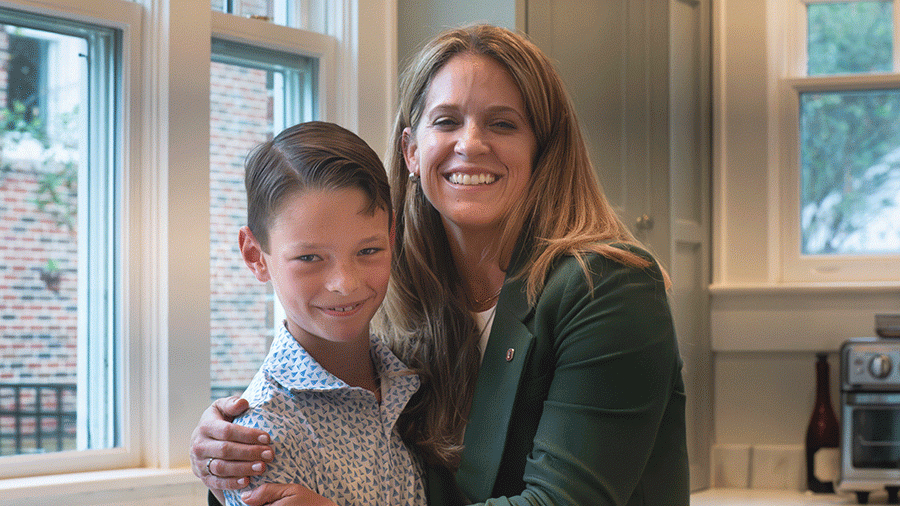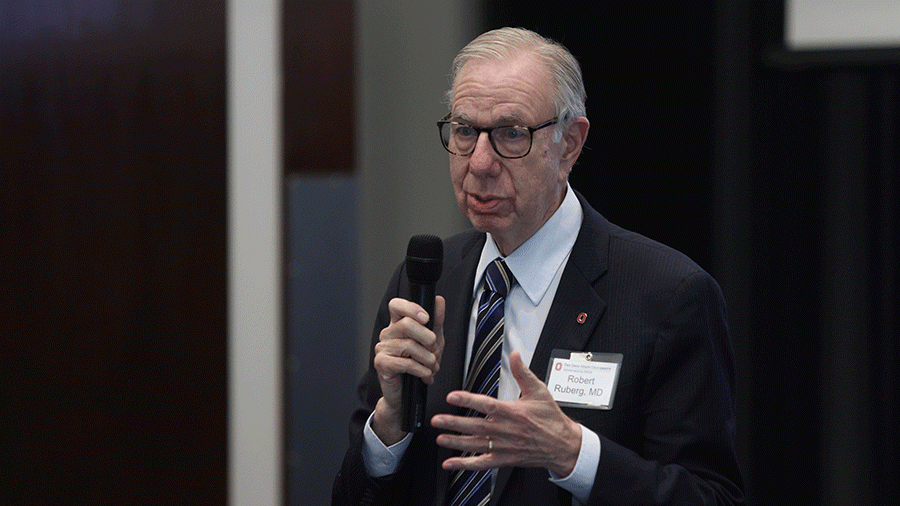Amy Moore, MD, FACS, with students in front of Meiling Hall.
Aligning talent, purpose and generosity

Richard Williams, MD, who now practices in Cincinnati, completed his residency in plastic and reconstructive surgery at The Ohio State University College of Medicine in the late ’80s. He enjoyed the program largely because of the warmth, character and talent of its faculty.
So, when given the opportunity to honor one of them by supporting an endowed chair, he did not hesitate. “It was a no brainer for me to give,” he says.
In addition to Dr. Williams, more than 30 alumni, along with colleagues, friends, family and grateful patients, have contributed to The Robert L. Ruberg, MD, Alumni Chair in Plastic and Reconstructive Surgery, established in 2013.
Endowed chair positions are among the highest recognitions for exceptional faculty. “They attract the best talent,” Dr. Williams says. The lives changed by the Ruberg Chair — those who contribute to, are honored by and benefit from it — reveal it.
Elevating education, research and patient care
Amy Moore, MD, FACS, one of very few peripheral nerve surgeons in the world, joined Ohio State in 2019 as the Ruberg Chair.
Dr. Moore’s dream of becoming a physician started young, while volunteering at a Veterans Affairs hospital with her father, who served in the U.S. Army and later in the VA medical system as an administrator.
As a clinician, Dr. Moore operates on the peripheral nervous system, which comprises the nerves that extend from the spinal cord to muscles and skin. Sometimes, surgery involves nerve rewiring or transferring.
“For example, we have two muscles that bend the wrist. We can rewire one of the nerves from the wrist to instead power the bending of the elbow, and the brain can handle this change because of its plasticity (its ability to adapt),” she says.
The outcome of the nerve reconstruction surgeries Dr. Moore performs are life altering, as in the case of Byron Heersink, 10, from Dothan, Alabama. After a traumatic injury, his right arm hung limp due to nerve damage. Dr. Moore’s surgery, along with rigorous rehabilitation fully restored Heersink’s mobility.

Dr. Moore says being able to improve a patient’s quality of life drives everything she does. “A patient might come to me in pain, with a lack of motion, or they can’t feel — and I can perform surgery that alleviates pain and can restore function.”
Passionate about helping those who serve, she helped develop Ohio State’s Military Medicine Program to provide surgical reconstruction and pain management care for wounded service members. She also conducts related translational research with funding from the U.S. Department of Defense.
The Ruberg Chair was key to Dr. Moore’s decision to join Ohio State. “An endowed chair speaks volumes of the institution’s commitment to the discipline and its leadership,” she says. It is also an incredible honor. “I’m trying to make sure I make Dr. Ruberg proud.”
Standing on the shoulders of those who came before
In 1975, after graduating from Harvard Medical School and residency at the University of Pennsylvania, Dr. Ruberg joined Ohio State expecting to stay five to 10 years. He stayed nearly four decades before retiring. “I found it to be a great place where I was given so many different opportunities to advance,” he says.
Dr. Ruberg started as an assistant professor and rose to head of plastic surgery and director of the residency program. During his last year, he served as dean for education in the College of Medicine. “My greatest delight was in being involved in the education of medical students,” he says.

After retiring, Dr. Ruberg continued helping the department in various capacities, including helping Dr. Moore acclimate to her new role as his namesake chair.
A chair directs the department’s engagement in teaching, research and service — and they set the vision and direction to advance science and promote the specialty. Dr. Ruberg knew Dr. Moore was exactly the person for the job.
“Dr. Moore is someone with a world-class reputation who also happens to be a wonderful individual and a very inspiring leader for the other junior members of the faculty,” he says.
“I was able to achieve everything I wanted to in my profession, and I had the distinction of being at Ohio State,” says Dr. Ruberg, adding that having a chair named after him was the ultimate highlight and most important achievement of his career.

Paying forward and paying tribute
Among the more than 100 students Dr. Ruberg trained as plastic surgeons, he credits Dr. Williams with helping drive the department’s growth.
“Dr. Ruberg was a gentleman’s gentleman, totally dedicated to resident education,” says Dr. Williams, who has supported his mentor’s chair from the start.
Dr. Williams says the choice to come to Ohio State was easy, but it represented a big change for his family. His wife Sherry had to leave her job and home in northern Kentucky. And they were expecting their first child.
Upon meeting the faculty and their families, including Dr. Ruberg and his wife Cindy, Dr. Williams knew the program would be everything he expected it to be. “I had nothing but favorable experiences.”
Dr. Williams says the longer he is in practice, the more he appreciates the foundation he obtained at Ohio State, which motivates him to support the people and program that trained him and made a large university feel like a small town. When he met Dr. Moore, her humility and appreciation showed him the department “got the right hire.”
The official ceremony to appoint Dr. Moore as the Ruberg Chair was held in 2023. On that day, a joke could have been made about three surgeons walking into a room. There were more in attendance, but Drs. Moore, Ruberg and Williams have something special in common — they make the long–lasting and multifaceted impact of endowed chairs come alive through their talent, actions and generosity.